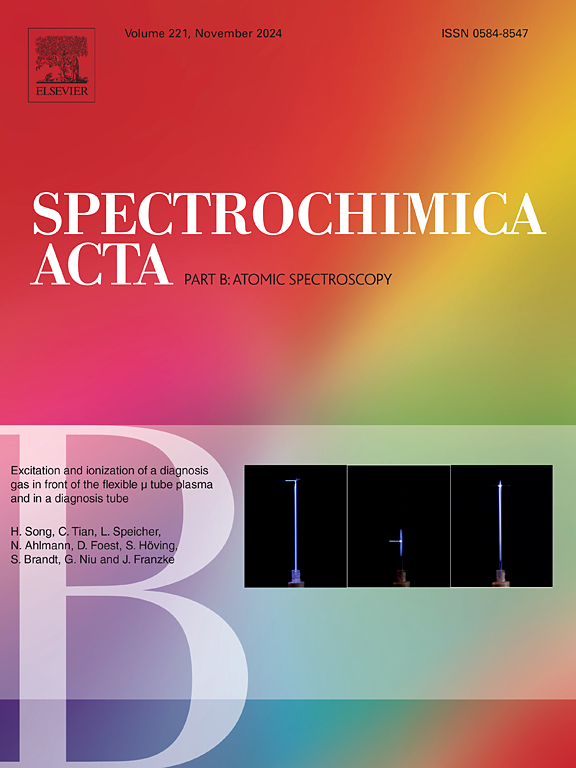通过吸收和发射光谱法评估 SC-GD 中的分析物转移率和激发条件
IF 3.8
2区 化学
Q1 SPECTROSCOPY
引用次数: 0
摘要
溶液阴极辉光放电(SCGD)是一种紧凑的雾化/激发源,使用水溶液作为放电阴极,在环境空气中持续存在,当与光学发射光谱(OES)耦合时,对元素周期表中的许多元素提供中低ng/mL范围内的检测限(lod)。甲酸(HCOOH)经常作为提高灵敏度的添加剂加入进料溶液中;然而,一些报告表明,这种添加剂的好处取决于在溶液中存在的伴随离子。人们普遍认为,分析灵敏度的提高是由于HCOOH引起的较高的分析物转移率提高了采样效率;因此,共存离子被认为可能通过改变液等离子界面的分析物转移速率来改变这种添加剂的影响。本工作旨在利用原子吸收光谱法(AAS)研究相应溶液含量下SCGD中分析物溶液到等离子体的转移。为此,利用脉冲氙灯作为辐射源,建立了SCGD-AAS系统并对其进行了表征。在以下情况下记录了Mg I (285.2 nm)、Cu I (324.7 nm)、Ag I (328.1 nm)和Li I (670.8 nm)共振跃迁对应的吸收信号和发射信号:(1)正离子或阴离子浓度达到60 mM时,包括Na+、Ca2+、NO3−或Cl−;(2)浓度0 ~ 7%的氢cooh;(3)上述离子与HCOOH共存在。这些结果为讨论实际样品中常见共存的阳离子和阴离子的影响以及添加常见的灵敏度增强剂HCOOH对SCGD中分析物转移机制的影响提供了信息,从而了解该技术的一般工作原理以及与OES检测相结合时可能出现的基质效应。本文章由计算机程序翻译,如有差异,请以英文原文为准。

Evaluation of analyte transfer rates and excitation conditions in the SC-GD by absorption and emission spectrometry
The solution cathode glow discharge (SCGD) is a compact atomization/excitation source sustained under ambient air using an aqueous solution as discharge cathode, offering limits of detection (LODs) for many elements in the periodic table within the mid to low ng/mL range when coupled to optical emission spectrometry (OES). Formic acid (HCOOH) is frequently included in the incoming solution as an additive for improved sensitivity; however, some reports have shown that the benefit of this additive depends on the concomitant ions present in the solution. It is widely assumed that the improvement in the analytical sensitivity comes from an enhanced sampling efficiency produced by a higher analyte transfer rate caused by HCOOH; accordingly, the coexisting ions are considered to alter the impact of this additive, probably through changing analyte transfer rates at the liquid-plasma interface. This work aims to provide a perspective of the analyte solution-to-plasma transfer in the SCGD at relevant solution content by means of atomic absorption spectrometry (AAS). For this purpose, a SCGD-AAS system was built and characterized using a pulsed Xenon lamp as radiation source. The absorption signals, together with the emission signals, corresponding to resonant transitions of Mg I (285.2 nm), Cu I (324.7 nm), Ag I (328.1 nm) and Li I (670.8 nm) were recorded at the following situations: (1) cation or anion concentrations up to 60 mM, including Na+, Ca2+, NO3− or Cl−; (2) HCOOH at concentrations ranging 0–7 %; (3) co-presence of the mentioned ions and HCOOH. The results provide information to discuss the influence of common coexisting cations and anions in real samples, together with the addition of a common sensitivity enhancer, HCOOH, on analyte transfer mechanisms in the SCGD, to understand the general working fundamentals of the technique and possible matrix effects when combined with OES detection.
求助全文
通过发布文献求助,成功后即可免费获取论文全文。
去求助
来源期刊
CiteScore
6.10
自引率
12.10%
发文量
173
审稿时长
81 days
期刊介绍:
Spectrochimica Acta Part B: Atomic Spectroscopy, is intended for the rapid publication of both original work and reviews in the following fields:
Atomic Emission (AES), Atomic Absorption (AAS) and Atomic Fluorescence (AFS) spectroscopy;
Mass Spectrometry (MS) for inorganic analysis covering Spark Source (SS-MS), Inductively Coupled Plasma (ICP-MS), Glow Discharge (GD-MS), and Secondary Ion Mass Spectrometry (SIMS).
Laser induced atomic spectroscopy for inorganic analysis, including non-linear optical laser spectroscopy, covering Laser Enhanced Ionization (LEI), Laser Induced Fluorescence (LIF), Resonance Ionization Spectroscopy (RIS) and Resonance Ionization Mass Spectrometry (RIMS); Laser Induced Breakdown Spectroscopy (LIBS); Cavity Ringdown Spectroscopy (CRDS), Laser Ablation Inductively Coupled Plasma Atomic Emission Spectroscopy (LA-ICP-AES) and Laser Ablation Inductively Coupled Plasma Mass Spectrometry (LA-ICP-MS).
X-ray spectrometry, X-ray Optics and Microanalysis, including X-ray fluorescence spectrometry (XRF) and related techniques, in particular Total-reflection X-ray Fluorescence Spectrometry (TXRF), and Synchrotron Radiation-excited Total reflection XRF (SR-TXRF).
Manuscripts dealing with (i) fundamentals, (ii) methodology development, (iii)instrumentation, and (iv) applications, can be submitted for publication.

 求助内容:
求助内容: 应助结果提醒方式:
应助结果提醒方式:


